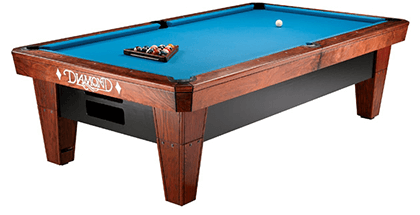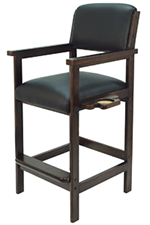The Rules of Play From World Pool-Billiard Association
The following actions are fouls at pool when included in the specific rules of the game being played. If several fouls occur on one shot, only the most serious one is enforced. If a foul is not called before the next shot begins, the foul is assumed not to have happened.
6.1 Cue Ball Scratch or off the Table
If the cue ball is pocketed or driven off the table, the shot is a foul. See 8.3 Ball Pocketed and 8.5 Driven off the Table.
6.2 Wrong Ball First
In those games which require the first object ball struck to be a particular ball or one of a group of balls, it is a foul for the cue ball to first contact any other ball.
6.3 No Rail after Contact
If no ball is pocketed on a shot, the cue ball must contact an object ball, and after that contact at least one ball (cue ball or any object ball) must be driven to a rail, or the shot is a foul. (See 8.4 Driven to a Rail.)
6.4 No Foot on Floor
If the shooter does not have at least one foot touching the floor at the instant the tip contacts the cue ball, the shot is a foul.
6.5 Ball Driven off the Table
It is a foul to drive an object ball off the table. Whether that ball is spotted depends on the rules of the game. (See 8.5 Driven off the Table.)
6.6 Touched Ball
It is a foul to touch, move or change the path of any object ball except by the normal ball-to- ball contacts during shots. It is a foul to touch, move or change the path of the cue ball except when it is in hand or by the normal tip-to-ball forward stroke contact of a shot. The shooter is responsible for the equipment he controls at the table, such as chalk, bridges, clothing, his hair, parts of his body, and the cue ball when it is in hand, that may be involved in such fouls. If such a foul is accidental, it is a standard foul, but if it is intentional, it is 6.16 Unsportsmanlike Conduct.
6.7 Double Hit / Frozen Balls
If the cue stick contacts the cue ball more than once on a shot, the shot is a foul. If the cue ball is close to but not touching an object ball and the cue tip is still on the cue ball when the cue ball contacts that object ball, the shot is a foul. If the cue ball is very close to an object ball, and the shooter barely grazes that object ball on the shot, the shot is assumed not to violate the first paragraph of this rule, even though the tip is arguably still on the cue ball when ball-ball contact is made.
However, if the cue ball is touching an object ball at the start of the shot, it is legal to shoot towards or partly into that ball (provided it is a legal target within the rules of the game) and if the object ball is moved by such a shot, it is considered to have been contacted by the cue ball. (Even though it may be legal to shoot towards such a touching or “frozen” ball, care must be taken not to violate the rules in the first paragraph if there are additional balls close by.)
The cue ball is assumed not to be touching any ball unless it is declared touching by the referee or opponent. It is the shooter’s responsibility to get the declaration before the shot. Playing away from a frozen ball does not constitute having hit that ball unless specified in the rules of the game.
6.8 Push Shot
It is a foul to prolong tip-to-cue-ball contact beyond that seen in normal shots.
6.9 Balls Still Moving
It is a foul to begin a shot while any ball in play is moving or spinning.
6.10 Bad Cue Ball Placement
When the cue ball is in hand and restricted to the area behind the head string, it is a foul to play the cue ball from on or below the head string. If the shooter is uncertain whether the cue ball has been placed behind the head string, he may ask the referee for a determination.
6.11 Bad Play from Behind the Head String
When the cue ball is in hand behind the head string, and the first ball the cue ball contacts is also behind the head string, the shot is a foul unless the cue ball crosses the head string before that contact. If such a shot is intentional, it is unsportsmanlike conduct.
The cue ball must either cross the head string or contact a ball in front of or on the head string or the shot is a foul, and the cue ball is in hand for the following player according to the rules of the specific game.
6.12 Cue Stick on the Table
If the shooter uses his cue stick in order to align a shot by placing it on the table without having a hand on the stick, it is a foul.
6.13 Playing out of Turn
It is a standard foul to unintentionally play out of turn. Normally, the balls will be played from the position left by the mistaken play. If a player intentionally plays out of turn, it should be treated like 6.16 Unsportsmanlike Conduct.
6.14 Three Consecutive Fouls
If a player fouls three times without making an intervening legal shot, it is a serious foul. In games scored by the rack, such as nine ball, the fouls must be in a single rack. Some games such as eight ball do not include this rule.
The referee must warn a shooter who is on two fouls when he comes to the table that he is on two fouls. Otherwise a possible third foul will be considered to be only the second.
6.15 Slow Play
If the referee feels that a player is playing too slowly, he may advise that player to speed up his play. If the player does not speed up, the referee may impose a shot clock on that match that applies to both players. If the shooter exceeds the time limit specified for the tournament, a standard foul will be called and the incoming player is rewarded according to the rules applicable to the game being played. (Rule 6.16 Unsportsmanlike Conduct may also apply.)
6.16 Unsportsmanlike Conduct
The normal penalty for unsportsmanlike conduct is the same as for a serious foul, but the referee may impose a penalty depending on his judgment of the conduct. Among other penalties possible are a warning; a standard-foul penalty, which will count as part of a three- foul sequence if applicable; a serious-foul penalty; loss of a rack, set or match; ejection from the competition possibly with forfeiture of all prizes, trophies and standings points.
Unsportsmanlike conduct is any intentional behavior that brings disrepute to the sport or which disrupts or changes the game to the extent that it cannot be played fairly. It includes
(b) changing the position of the balls in play other than by a shot;
(c) playing a shot by intentionally miscuing;
(d) continuing to play after a foul has been called or play has been suspended;
(e) practicing during a match;
(f) marking the table;
(g) delay of the game; and
(h) using equipment inappropriately.


 Free Shipping with Tracking on orders over $100 within the Continental USA.
Free Shipping with Tracking on orders over $100 within the Continental USA. 




